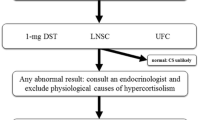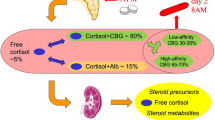Abstract
Patients with Cushing syndrome have elevated 24 h urinary free cortisol excretion and loss of diurnal rhythm of plasma cortisol, however, morning total plasma cortisol concentrations are often similar to those of normal individuals. To test the hypothesis that an elevated morning plasma free cortisol could distinguish patients with Cushing syndrome from those without the disorder, we measured plasma free cortisol levels at 08:00 in 20 patients with surgically-confirmed mild Cushing syndrome, 19 patients with pseudo-Cushing states, and 9 normal volunteers. We then determined the sensitivity, specificity and diagnostic accuracy of plasma free cortisol for the diagnosis of hypercortisolism and for the diagnosis of Cushing syndrome. Plasma free cortisol was compared to 08:00 total plasma cortisol and to basal 24 hour urinary free cortisol. Morning plasma free cortisol was significantly elevated in patients with mild Cushing syndrome (58±6 nmol/L; mean±SE) compared to plasma free cortisol in patients with pseudo-Cushing states (36±6 nmol/L) (ps<0.005) and normal volunteers (22±4 nmol/L) (ps<0.0005). Total morning cortisol was significantly greater in patients with mild Cushing syndrome (470±28 nmol/L) than in normal volunteers (310±33 nmol/L, ps<0.05) but was not different from patients with pseudo-Cushing states (410±47 nmol/L, p=NS). Urinary free cortisol was also significantly greater in mild Cushing syndrome (540±50 nmol/d) than in patients with pseudo-Cushing states (430±41 nmol/d, p<0.05) or normal volunteers (160±28 nmol/d, p<0.0001). However, there was considerable overlap of plasma free cortisol, plasma total cortisol and urinary free cortisol between the three groups precluding these tests alone from being useful to distinguish patients with mild Cushing syndrome from patients with pseudo-Cushing states. To achieve 100% sensitivity for the diagnosis of Cushing syndrome, the specificity for plasma free cortisol, plasma total cortisol and urinary free cortisol was 0.11, 0.32 and 0.32, respectively. We conclude that plasma free cortisol is of limited value in the differential diagnosis of hypercortisolism.
Similar content being viewed by others
References
Daughaday W.H. Binding of corticosteroids by human plasma proteins. IV. The electrophoretic demonstration of corticosteroid binding globulin. J. Clin. Endocrinol. Metab. 37: 519, 1958.
Slaunwhite W.R., Lockie G.N., Back N., Sandberg A.A. Inactivity in vivo of transcortin-bound cortisol. Science 135: 1062, 1962.
Brien T.G. Free cortisol in human plasma. Horm. Metab. Res. 12: 643, 1980.
Doe R.P., Zinneman H.H., Flink H.B., Ulstrom R.A. Significance of the concentration of non protein bound plasma cortisol in normal subjects, Cushing’s syndrome, pregnancy and during estrogen therapy. J. Clin. Endocrinol. Metab. 20: 1484, 1960.
Doe R.P., Fernandez R., Seal U.S. Measurement of corticosteroid binding globulin in man. J. Clin. Endocrinol. Metab. 24: 1029, 1964.
Sandberg A.A., Slaunwhite W.R. Transcortin: a corticosteroid binding protein in plasma. II. Levels in various conditions and the effect of estrogens. J. Clin. Invest. 38: 1290, 1959.
Musa B.U., Seal U.S., Doe R.P. Serum protein alterations in women by synthetic estrogens. J. Clin. Endocrinol. Metab. 27: 1463, 1967.
Luton J.-P., Cedras S., Billaud L., Thomas G., Guilhaume B., Bertagna X., Laudat M.-H., Louvel A., Chapius Y., Blondeau P., Bonnin A., Bricaire H. Clinical features of adrenocortical carcinoma, prognostic factors, and the effect of mitotane therapy. N. Engl. J. Med. 322: 1195, 1990.
Perini G.I., Devinsky O., Hauser P., Gallucci W.T., Theodore W.H., Chrousos G.P., Gold P.W., Kling M.A. Effects of carbamazepine on pituitary-adrenal function in healthy volunteers. J. Clin. Endocrinol. Metab. 74: 406, 1992.
Nieman L.K., Chrousos G.P., Schulte H.M., Loriaux D.L., Nisula B.C. Adrenal regulation of corticosteroid-binding globulin (CBG). 7th International Congress of Endocrinology (Abstract) 1672, 1984.
Frairia R., Agrimonti F., Fortunati N., Fazzari A., Gennari P., Berta L. Influence of naturally occurring and synthetic glucocorticoids on corticosteroid-binding globulin-steroid interaction in human peripheral plasma. Ann. N.Y. Acad. Sci. 538: 287, 1988.
Schlechte JA, Hamilton D. The effect of glucocorticoids on corticosteroid binding globulin. Clin. Endocrinol. 27: 197, 1987.
Robin P., Pedine J., Milgrom E. Assay of unbound cortisol in plasma. J. Clin. Endocrinol. Metab. 46: 277, 1977.
Burke C.W., Roulet F. Increased exposure of tissues to cortisol in late pregnancy. Br. Med. J. 1: 657, 1970.
Murray D. Cortisol binding to plasma proteins in man in health, stress and at death. J. Endocrinol. 39: 571, 1967.
Kley H.K., Bartmann E., Kruskemper H.L. A simple and rapid method to measure non-protein bound fractions of cortisol, testosterone and oestradiol by equlibrium dialysis: comparison with centrifugal filtration. Acta Endocrinol. (Copenh.) 85: 209, 1977.
Yanovski J.A., Cutler G.B. Jr., Chrousos G.P., Nieman L.K. Corticotropin-releasing hormone stimulation following low-dose dexamethasone administration: A new test to distinguish Cushing’s syndrome from pseudo-Cushing’s states. J. Am. Med. Assoc. 269: 2232, 1993.
Jerkunica I., Sophianopoulos J., Sgoutas D. Improved ultrafiltration method for determining unbound cortisol in plasma. Clin. Chem. 26: 1734, 1980.
Foster L.B., Dunn R.T. Single-antibody technique for radioimmunoassay of cortisol in unextracted serum or plasma. Clin. Chem. 20: 365, 1974.
Ruder H.J., Guy R.L., Lipsett M.B. A radioimmunoassay for cortisol in plasma and urine. J. Clin. Endocrin. Metab. 35: 219, 1972.
Brownlee K.A. The correlated two × two table. In: Shewhart W.A., Wilks S.S., Bradley R.A., Hunter S.J., Kendall D.G., Watson G.S. (Eds.), Statistical theory and methodology in science and engineering. Wiley and Sons, New York, 1984, p. 262.
Swets J.A. Measuring the accuracy of diagnostic systems. Science 240: 1285, 1988.
Crapo LM. Cushing’s syndrome: a review of diagnostic tests. Metab. 28: 955, 1979.
Gold P.W., Loriaux D.L., Roy A., Kellner C.H., Post R.M., Kling MA, Calabrese J.R., Oldfield E.H., Pickar D., Avgerinos P.C., Paul S.M., Cutler Jr. G.B., Chrousos G.C. Physiology of hypercortisolism in depression and Cushing’s disease. N. Engl. J. Med. 314: 1329, 1986.
Gold P.W., Kling M.A., Whitfield H.J., Rabin D., Margioris A., Kalogeras K., Demitrack M., Loriaux D.L., Chrousos G.P. The clinical implications of corticotropin-releasing hormone. Adv. Exp. Med. Biol. 245: 507, 1988.
Besser G.M., Edwards C.R.W. Cushing’s syndrome. In: Mason A.S. (Ed.), Clinics in Endocrinology and Metabolism. WB Saunders, London, 1972, p. 451.
James V.H.T., Landon J., Wynn V. A fundamental defect of adrenocortical control in Cushing’s disease. J. Endocrinol. 40: 15, 1968.
Author information
Authors and Affiliations
Rights and permissions
About this article
Cite this article
Friedman, T.C., Yanovski, J.A. Morning plasma free cortisol: Inability to distinguish patients with mild Cushing syndrome from patients with pseudo-Cushing states. J Endocrinol Invest 18, 696–701 (1995). https://doi.org/10.1007/BF03349791
Accepted:
Published:
Issue Date:
DOI: https://doi.org/10.1007/BF03349791




